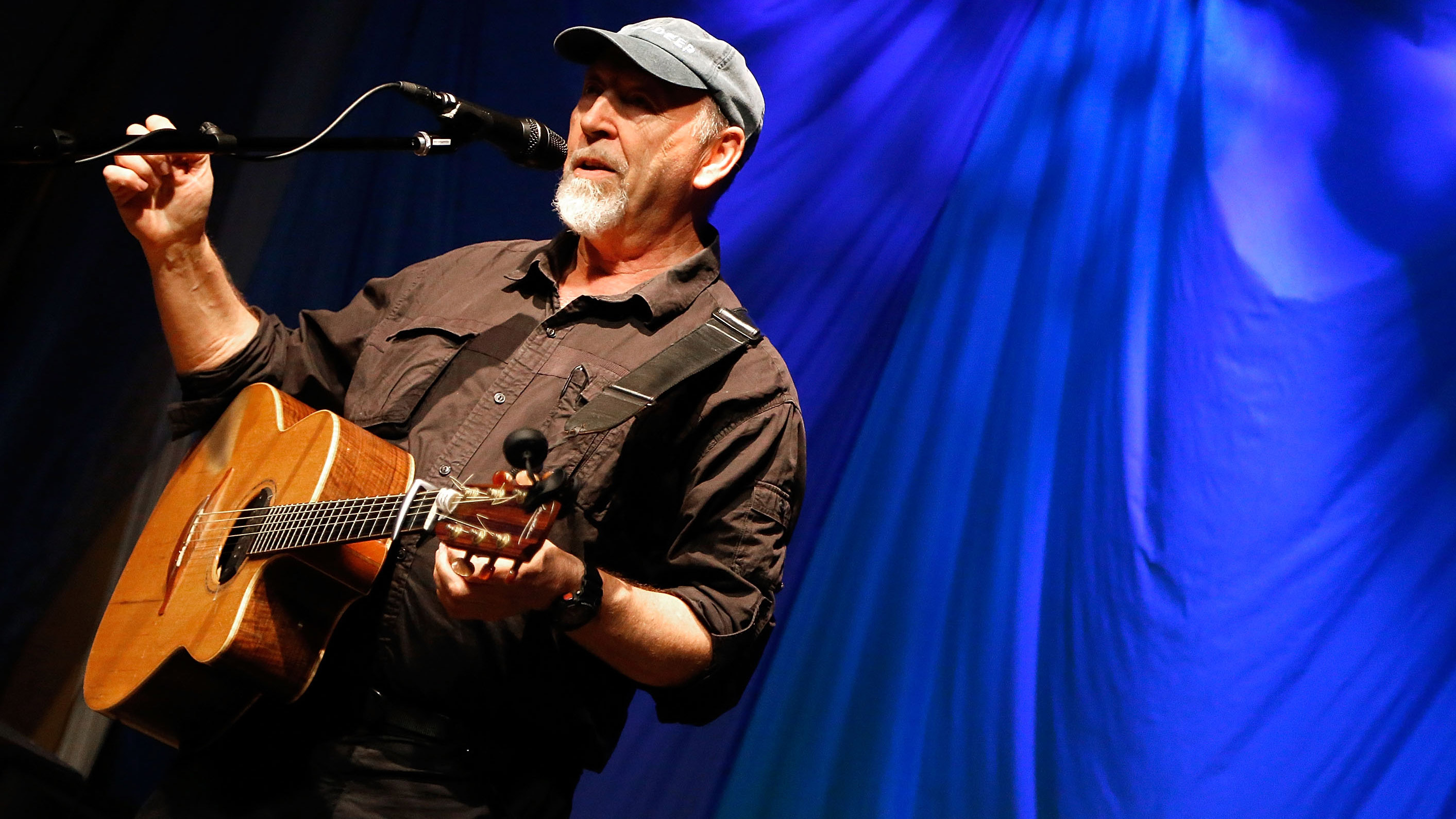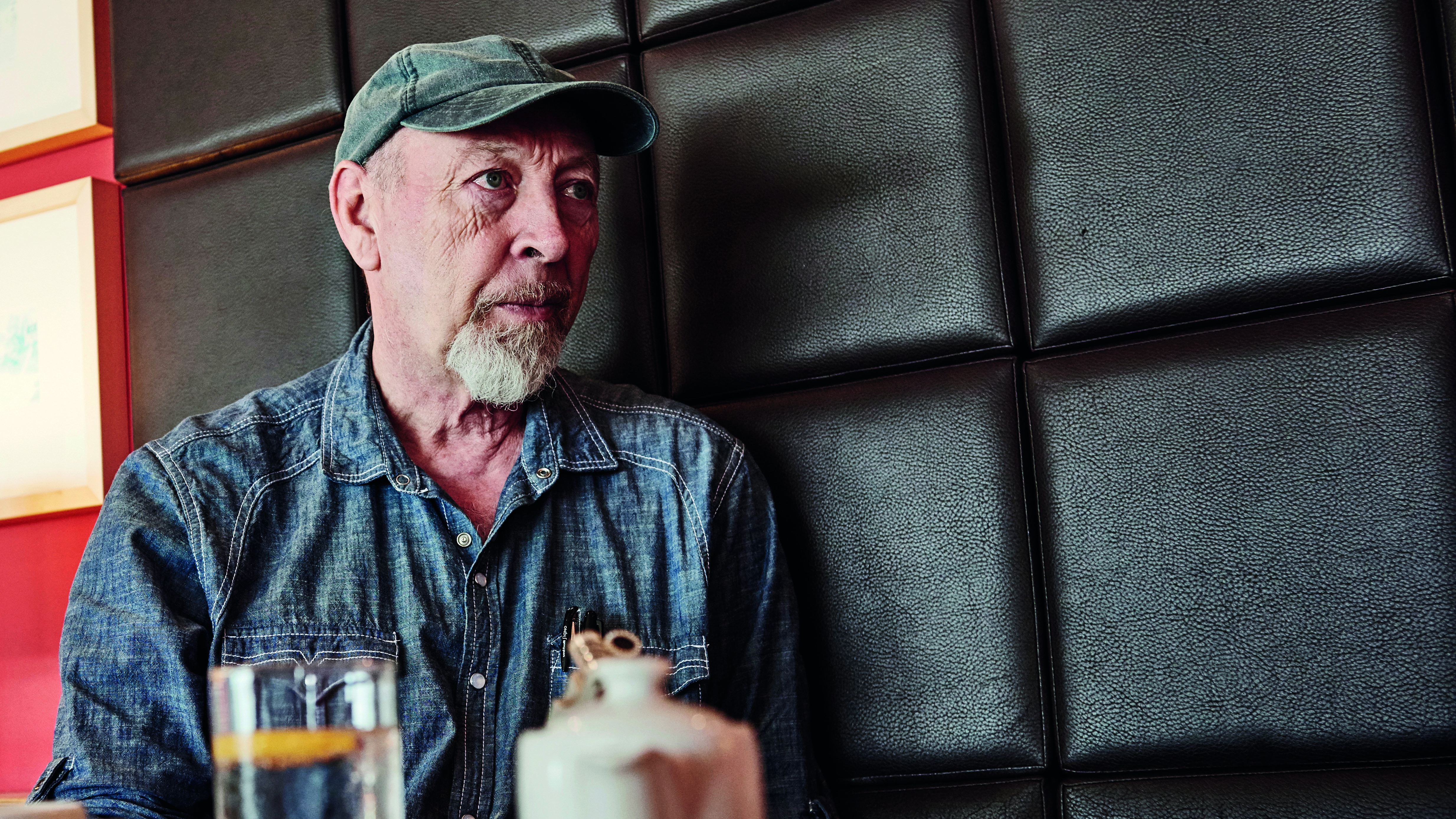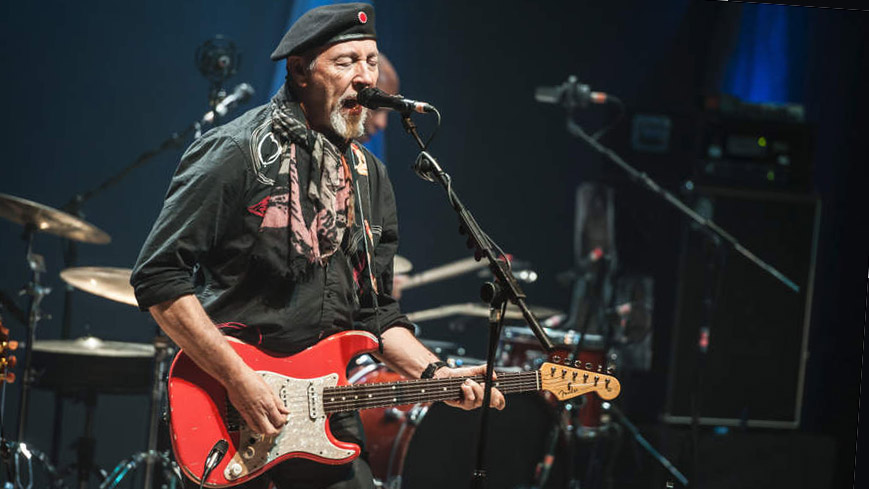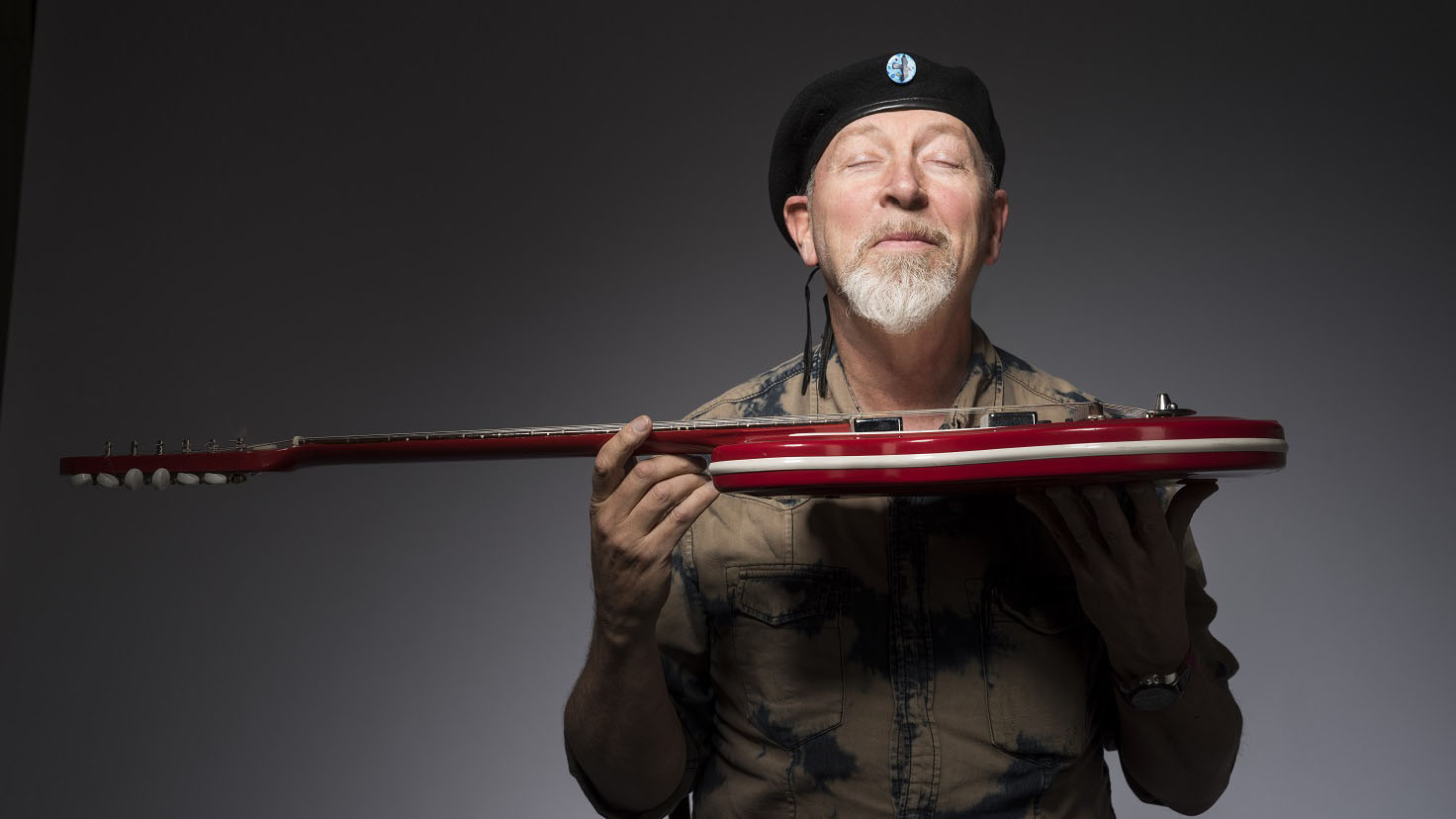Richard Thompson: "I think you can dream a song – you can hear the whole thing in your head"
Folk veteran reveals songwriting secrets and guitar tone tips

The annual Cropredy Festival in Oxfordshire is a high point in the folk rock calendar and this year’s event was especially significant as it marked hosts Fairport Convention’s 50th anniversary.
So, naturally, when we found ourselves sitting in an out-of-hours restaurant with Fairport founder member and all-round folk legend Richard Thompson, our opening gambit was to ask how the momentous occasion had gone for him on a personal level.
“Cropredy was fun. Historic 50th year… this means we must have started when I was three.” he deadpans. “We were always friends, which is a nice thing. Even people who left the band didn’t drift too far away. It’s always a joyful thing to get back together and play with those guys.”
Resident now in the US, Richard’s appearances at Cropredy these days are sparse. “I did it every year for a while in the 80s,” he continues. “It was a bit like my life flashing before my eyes; a year never seemed to be a year long. It’s Cropredy again. Oh, here it is again; oh, and again! So I spread them out a bit more and maybe do it every two or three years.”
With his solo career outside of the Fairport family now established, we’re here to talk about the release of the next chapter in his Acoustic Classics series. Was he surprised at the success of the first instalment?
“The first one was really designed for the merchandise table. Someone comes to a concert and on the way out they say, ‘Have you got a CD something like what I just heard?’ So rather than have a live CD – I’m not always comfortable with live CDs – I thought I’d just record a popular selection; the kind of thing I’m playing live right now.
"It was never going to be generally released but my management heard it and said they’d like to put it out as well. Then the record company in the UK picked it up and it was a top 10 album in the UK. At that time that meant you’d sold 22 copies! But, nevertheless, top 10 is top 10. So there was obviously a kind of hole there. Hence volume two.”

So the two albums are a sort of Best Of…?
“I suppose so, yes. I’m not picking songs that I’ve recorded solo too much before. If there’s been a gap of maybe 20 years, 30 years, I’ll go back and revisit an acoustic song, but often these are songs that, in their original incarnation, were with a band or with somebody else singing. There are two Fairport songs on this one, so I’m preferring to put on reinterpretations rather than rehashes.”
There are acoustic versions of songs that you’ve performed using electric guitar with a band. Is there something that marks a new song as either acoustic or electric?
A lot of songs are open to both interpretations, acoustic or electric, and if I’m working up to a band album then I’ll be thinking, ‘Okay, what works for a band?’
“I think if it’s a good song it could be either. A lot of songs are open to both interpretations, acoustic or electric, and if I’m working up to a band album then I’ll be thinking, ‘Okay, what works for a band?’
"If I’m working up to an acoustic album – I don’t make that many acoustic albums – I’ll be thinking about acoustic, acoustic, acoustic. If I’m playing acoustic live then I think, ‘I can adapt this song off the last record acoustically’. So there’s some flexibility.”
While you’re revisiting your back catalogue in this way, is there a temptation to meddle or rearrange songs?
“It depends on how satisfied you were in the first place. If you thought it was a definitive recording then you probably wouldn’t record it again or you’d just leave it alone and say that’s it. Know when to stop.”
Did you use your Lowden signature model for the album?
“Yes, this is the Lowden signature model for the whole recording. George Lowden approached me about doing a signature model and said, ‘You’ve been with us a long time and we’re doing one for Pierre Bensusan, we’re doing one for Thomas Leeb.’
"Over the years, I’ve tried various Lowdens and George would say, ‘What do you think of this one?’ and I really liked ziricote and cedar because it was kind of punchy – punchy and very even, kind of warm. It’s just a great fingerstyle guitar and incredibly responsive from quiet to loud – and then you push it and it will go louder and kind of keep going in a way I’ve never heard a guitar do before. It’s not a guitar I take on the road right now – that one stays in the studio – and, for live, I use a walnut and cedar Lowden, which is also a great guitar; very even response, so it’s good to use with pickups.”
Was the choice of walnut yours or did George advise you that might be a good tonewood to explore?
“I just said to George, ‘My road Lowden is getting seriously clapped out…’ and that’s what he sent me and I thought, ‘This sounds great’. I hardly have to EQ it live because it’s got such an even response. Usually, with an acoustic, there’s a couple of spots where you have to dig in a little bit with EQ just to even stuff out.”

You use a soundhole pickup, don’t you?
“Yeah, I use a Sunrise soundhole pickup and a small condenser mic inside the guitar. Then that’s blended through a Gas Cooker, which is a two-channel tube pre-amp made by Ridge Farm Studios and it’s just an extraordinary box. There’s nothing like it for warming up the electronics of guitar pickups.
"The magnetic pickup you can crank up forever – that has a lot of volume – and the mic gives some air around it.”
What’s your preference for electric guitars at present?
“Strats and Teles that are assembled for me by my guitar tech Bobby Eichorn. He kind of throws these together and puts in the combination of pickups that I like. I don’t know what they are; I think in some positions he uses Rio Grandes.
"He throws in different things and I don’t know what they are, I just say, ‘This sounds great!’ Bobby made me a three-pickup Tele and he’s just finished a three-pickup Tele 12-string, which is great.”
What about amplification?
“In the UK I keep a ’65 Fender Deluxe, which is sounding really good. I just used it at Cropredy and it sounded wonderful. I forget what speakers are in there right now – I think they’re Celestion Vintage 30s in there.
"In the States I use my favourite go-to stage amp, a Divided By 13, which has two different Celestion speakers in it – a Gold and a Green, I think. If I’m renting I’ll just rent a couple of Fender Deluxes – or perhaps three – and one of those usually works [laughs].”
Where does a new song begin with you?
You either have the lyrics that are looking for a tune or tunes that are looking for lyrics, and sometimes you get an idea of the whole thing at once
“You either have the lyrics that are looking for a tune or tunes that are looking for lyrics, and sometimes you get an idea of the whole thing at once. So you might get a line and the melody that goes with the line and you can expand from there in both directions. Otherwise you might write down a lyric and add the melody later, which gives a different flavour.
"Sometimes, you find to fit the lyrics in, you don’t want to change anything, so you might be dealing with half bars of music, which gives you a different approach to song writing. Sometimes I’ll just write down anything for a lyric; just write rubbish or incredibly clichéd lines and figure out something more interesting later.
"I think you can dream a song as well. You can hear the whole thing in your head and then you have to get back to that point; I can’t quite reach it but it’s there and I get the general idea but now I just have to write it down and that can take months to get to the actual nitty gritty.”
Do you actually write melodies out?
“I do, yes. I write tunes out in notation just so I don’t lose them. Sometimes I’ll go back through my notebook and they’ll be a melody from a year or two ago and I’ll think, ‘What the hell was I thinking?’ So what I’ve started to do much more is to use my phone as a kind of a shorthand storage device for tunes and I find that much better.
"I can hum something in or I can sing a lyric in and it’s got so many more components of what I want as a finished result. I can hear the feel that I’m intending. It’s much easier to go back to those little reference cues and figure out what I was thinking at the time. Because what you think at the time is so important and it’s getting back to that point again and not losing that.”
You use hybrid picking on acoustic guitar, don’t you?
“I use pick and fingers. Sometimes I use a thumb pick and fingers on acoustic for some songs because, after 57 years of playing the guitar, fingers one and two are still stronger than fingers two and three. So some things I can do on one and two I still can’t do on two and three. But there you go.”
Do you do the same on electric guitar?
I’d be sitting watching TV and be too lazy to put the pick down to go to fingerstyle or something so hybrid picking just became a thing
“Yes, I probably started hybrid picking on the electric, really. I never thought, ‘This is a great technique, I’ll use this…’ I think it was just laziness, you know? I’d be sitting watching TV and be too lazy to put the pick down to go to fingerstyle or something so it just became a thing.
"Then I discovered there’s things you can do with hybrid that you can’t do with any other technique. You can pick up and down on the lower strings and add things straight or syncopated with fingers – a whole new world that suits the style that I play because I play a fairly aggressive style of acoustic guitar.”
What tunings do you use?
“I try to limit myself with tunings so I’m not retuning every song. I use a lot of Drop D – I’m most always in Drop D, I’m hardly ever in straight tuning. There’s a lot of DADGAD and a lot of G modal, which is CGDGBE. I’ve other tunings but predominantly those are the three that I use. It just makes things easier. Makes it more streamlined.”
Do you use tunings on electric?
“I only use Drop D on electric. It’s just too messy to have arrays of electric guitars all in different tunings, I’m not sure it’s practical. I mean, the thing about open tunings on acoustic is that you’re trying to get more size from the instrument. You’re trying to get more notes ringing over and just generally a larger accompaniment sound.
"On electric it’s really not necessary. You have volume and you have accompanists; you’ve got bass, drums and maybe another guitar going so you don’t need all that.”
Richard Thompson's Acoustic Classics II and Acoustic Rarities are out now.


